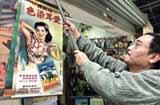 Sammy Wong hangs old Chinese advertising posters outside his shop in Hong Kong's Central district. Such posters, originating in Shanghai, have been gaining in popularity around the world.
Sammy Wong hangs old Chinese advertising posters outside his shop in Hong Kong's Central district. Such posters, originating in Shanghai, have been gaining in popularity around the world.
At first, it was just the simple details of a 1920s cigarette advertisement he saw in a Shanghai alley that captured his imagination: a beautiful Chinese woman with cheeks red with rouge, pearls hanging around her neck, a blue dress hugging her body.
Trond Lovdal, a Norwegian working in Taiwan, bought the deco ad poster and in the past six years, he has collected about 500 more originals. He is part of a growing number of art collectors, history buffs and antique lovers worldwide who are fascinated with the images on "Shanghai posters."
The pictures now appeal to Lovdal because he said they are a visual tour of the birth of modern commercialism in China, the liberation of Chinese women and the blending of Eastern and Western culture in the 1920 and 1930s in Shanghai - China's brash capital of style and business.
"Whenever you buy a new poster, you learn something new about that time," said Lovdal, who is the deputy director of the Norwegian Trade Office in Taiwan.
Lovdal is displaying 60 posters from his collection in the Taipei County Cultural Bureau's arts museum, according to The Associated Press.
In one picture, a pink floral silk gown appears to be slipping off the body of a smiling beauty with thick curls, revealing her bare back and her shapely thighs and calves.
An advertisement for Lever Bros. soap shows a woman in a lime-colored traditional "qipao" - a tight-fighting, high-necked dress with a slit that reaches high up the thigh.
When the pictures were made, Shanghai had already gained the reputation of being the "Paris of the East." The latest fashion, cultural and business trends flowed into the port city.
"People are fond of the posters because they represent the Shanghai back then which is very much like the Shanghai now," Lovdal said.
The posters are popping up everywhere - in Shanghai, Hong Kong and Singapore, as well as art galleries in Paris, Boston, New York, Tokyo and San Francisco. The motif lives on in postcards, coasters, refrigerator magnets and calendars.
When Lovdal started collecting posters, originals cost US$50. Now, they fetch as much as US$8,000 in places like New York, he said. He estimates his collection is worth at least US$40,000.
The posters revolutionized the advertising business in Shanghai. Before they appeared, ads by foreign companies featured past US presidents like Abraham Lincoln or George Washington and failed to catch the atten-tion of Chinese consumers.
It wasn't until a Christian missionary tipped off foreign companies how popular poster calendars were that the advertising fad began, said Wei Te-wen, a Taiwanese publisher and serious poster collector.
"It was the beginning of modern advertising in China," Wei said.
The range of products displayed increased with the popularity of the posters, and included some more familiar brands such as Ever Ready batteries, according to AP.
Many of the women who posed for the posters were movie stars. Among them, Ruan Lingyu, China's Marilyn Monroe, who had a similar fate to her American counterpart. She committed suicide at the age of 25, leaving behind only a note that read, "Rumors are deadly."
Although in many ways the posters exploited the woman as sex objects, they also celebrated the new liberation of women who weren't consumed by domestic drudgery and could go out and have fun, the Taiwanese poster collector.
(eastday.com April 3, 2002)
